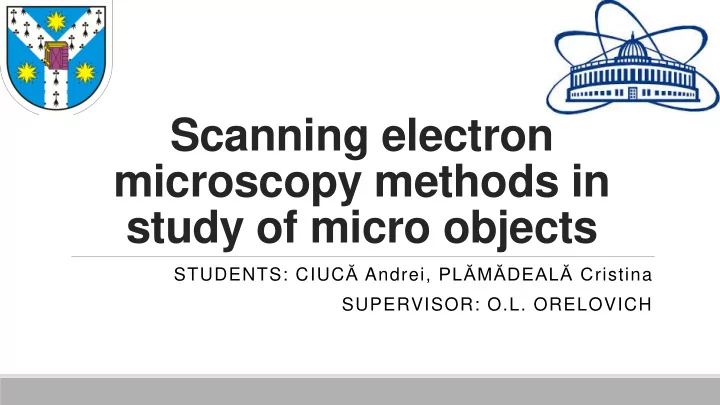

Scanning electron microscopy methods in study of micro objects STUDENTS: CIUC Ă Andrei , PLĂMĂDEALĂ C ristina SUPERVISOR: O.L. ORELOVICH
Table of contents • Introduction to SEM • Equipment • Sample preparation • Charging of sample • Tilted sample • Different types of samples: CD Salt Plant
Introduction to SEM • Electron source = thermo emission tungsten filament; • Electrons are accelerated and focused using magnetic lenses; • The beam is focused in 5-9 nm spot that scans the probe; • Secondary electrons are detected and analyzed, forming the image; • Electron microscopes allow the visualization of structures that would normally be not visible by optical microscope; • SEM offers higher resolution and depth of field when compared to optical microscopes. Fig. 1. Schematics of scanning electron microscope.
Equipment • JSM-840 is an analog SEM capable of high resolution images • Accelerating voltage can be varied from 1 kV up to 40 kV; • The uses of multiple detectors ensures a wide range of structural investigations: a backscattered electron detector, a secondary electron detector and a X-ray spectrometer; • Large specimen goniometer allows tilting and rotating of the sample in order to obtain a more detailed image. Fig. 2. JSM-840 electron microscope
Equipment • Hitachi TM3000 is a tabletop electron microscope. It is very portable and easy to operate. • 5 or 15 kV accelerating voltage can be used which leads to magnification range from 15 to 30000x; • It uses a semiconductor backscattered electron detector; • The software used on the control PC/notebook offers fast digital images which can be easily analyzed and transferred. Fig. 3. Hitachi TM3000 electron microscope
Sample preparation • Sample is fixed on specimen stages using silver glue, carbon or copper band depending on sample type; • For nonmetallic samples a thin layer of gold is applied to increase the coefficient of secondary electron emission, reduce sample charging and increase thermal conductivity; • An ion sputter uses plasma to coat the samples in gold. Fig. 4. Ion sputter schematics and sample placement.
Charging of sample Fig. 5a. Charging of sample due to lack of gold coating. Fig. 5b. Higher resolution due to gold coating.
Tilted sample Fig. 6a. Increase in contrast due to sample tilt (15, 60 degrees)
Tilted sample Fig. 6b. Better topographical details due to sample tilt (0 and 60 degrees).
Porous membranes measurements Fig. 7. Calculation of pore dimension and pore density used for porosity determination. High number of pores is required to reduce errors
CD Fig. 8 Structural difference between empty and written CD (10x magnification) .
Salt Fig. 9 NaCl crystals at different magnifications (50x and 150x)
Salt Fig. 10 NaCl crystal structural details. (600x and 5000x magnifications)
Plant Fig. 11 Plant sample preparation and SEM images of different structures.
Stalk Fig. 12 Plant stalk details.
Flower Fig. 13 Flower, and pollen structure.
Leaf Fig. 14 Leaf structure and topography.
Conclusions • Scanning electron microscopy offers high resolution images (up to 3 nm) which cannot be obtained in conventional optical microscopy and allow the visualization of structures that would normally be not visible by optical microscope; • The large depth of field of SEM (30 μ m), compared with optical microscopes (0.1 μ m), produce realistic 3D images which permit observation of multiple details; • The use of multiple detectors offer the possibility of observing not only topographical information but also of physical and chemical properties; • SEM is an invaluable tool whose practical applications can be employed in many fields of research
Thank you for your attention !
Recommend
More recommend